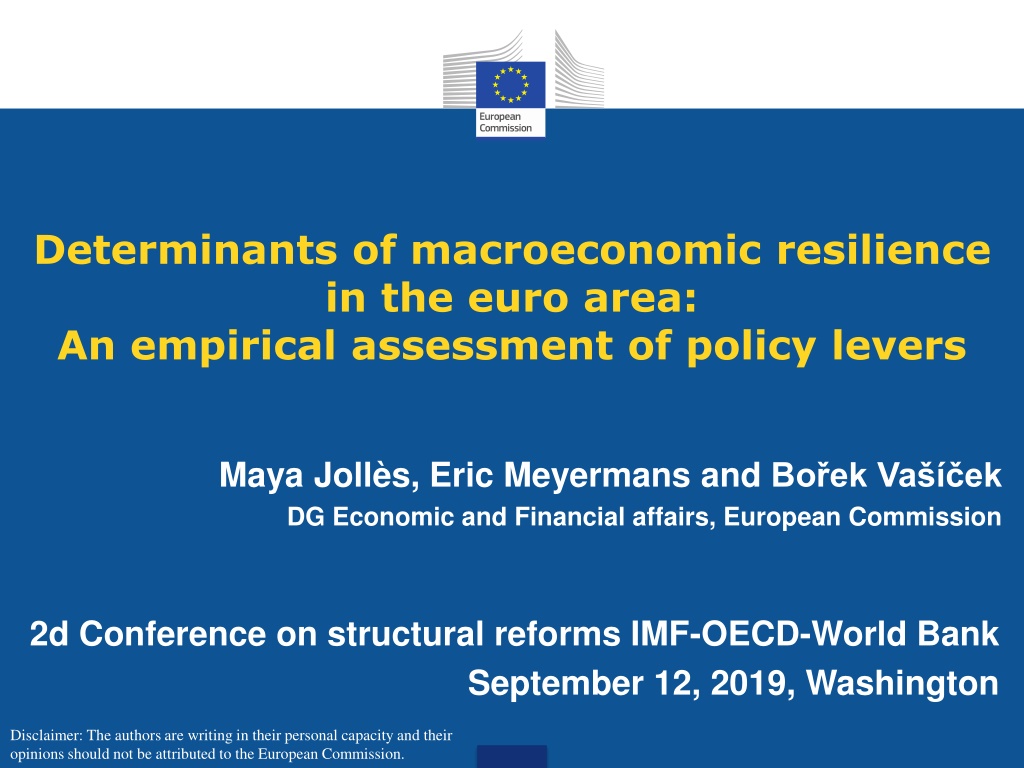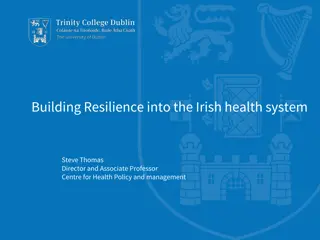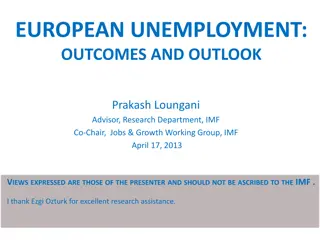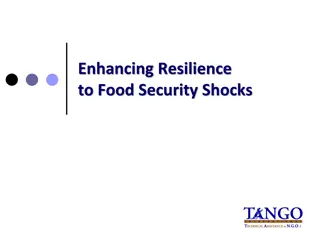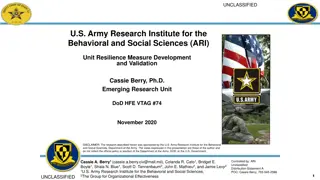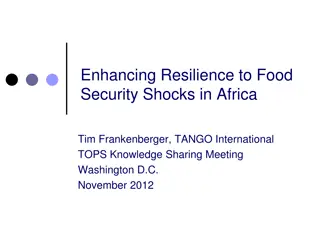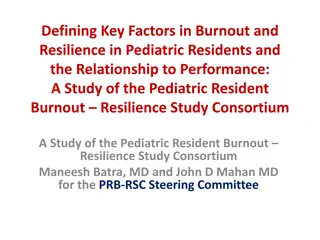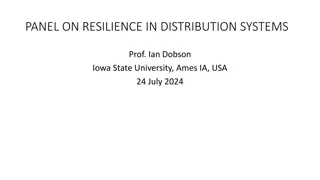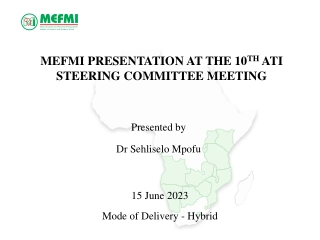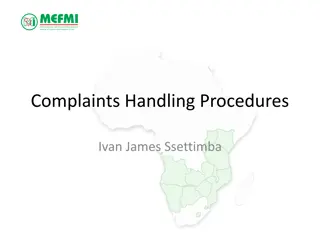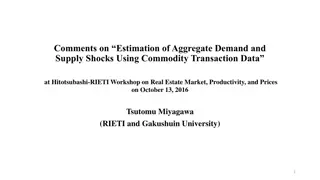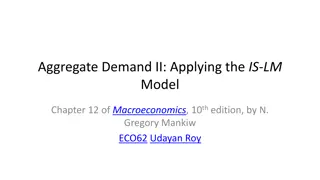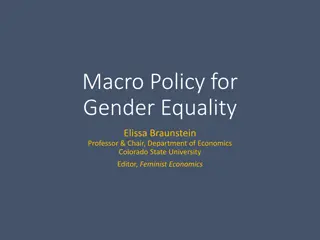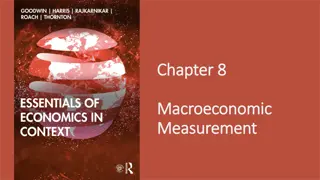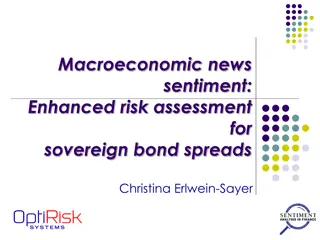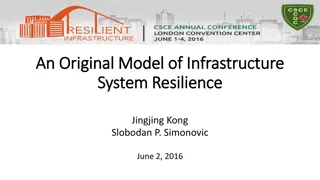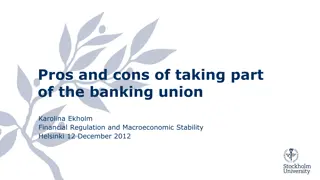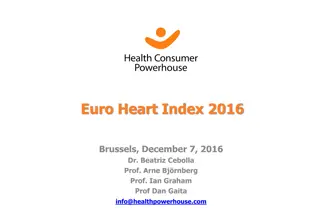Assessing Macroeconomic Resilience in the Euro Area
This study assesses the determinants of macroeconomic resilience in the Euro area, emphasizing the importance of economic resilience to absorb shocks, promote convergence, and achieve short-term gains like lower unemployment and higher income. The framework includes components such as absorption, recovery, vulnerability, and potential growth, with methodologies like panel regression and Bayesian Model Averaging being used to evaluate the impact of structural features.
Download Presentation

Please find below an Image/Link to download the presentation.
The content on the website is provided AS IS for your information and personal use only. It may not be sold, licensed, or shared on other websites without obtaining consent from the author. Download presentation by click this link. If you encounter any issues during the download, it is possible that the publisher has removed the file from their server.
E N D
Presentation Transcript
Determinants of macroeconomic resilience in the euro area: An empirical assessment of policy levers Maya Joll s, Eric Meyermans and Bo ek Va ek DG Economic and Financial affairs, European Commission 2d Conference on structural reforms IMF-OECD-World Bank September 12, 2019, Washington Disclaimer: The authors are writing in their personal capacity and their opinions should not be attributed to the European Commission.
Real GDP level (2008=100) Notes: EA=Euro area, EA hardest hit= Cyprus, Greece, Ireland, Portugal and Spain Source: Eurostat 2
Why is economic resilience so important in the euro area ? Necessary (but not sufficient) to absorb economic shocks via internal adjustment reduce amplitude and persistence business cycle Promote convergence across euro area Short-term gains less unemployment, higher income, Long-term gains averts hysteresis risks (Labour market, capital formation ) averts socio-political risks (political support for reforms, ) creates incentives to invest, innovate, compete, grow, . 3
assess determinants of macroeconomic resilience in the face of common shocks Overall objective: 4
Economic resilience framework: Components of resilience Absorption (i.e. ability to cushion the impact of shock) Recovery (i.e. persistence of the effects of shock) Vulnerability (i.e. likelihood being hit by a shock) Potential growth CONVERGENCE (cyclical and real) RESILIENCE 5
Methodologies to evaluate the impact of structural features I. Estimation of common shocks (17 countries) II. a) Panel regression (17 countries, 20 explanatory variables): reduced form output gap equation ? ?=1 ??,?= ??????_??+ ????,?,??????_?? impact of common shock + structural factors affecting its absorption ? ?=1 + ???,? 1+ ????,?,???,? 1 recovery from past output gaps + structural factors affecting recovery ??,? ??,?,? ? ?,? ? ?=1 + ??,? + impact macro-economic policy variables + stochastic component II. b) Bayesian Model Averaging (BMA) in panel (40 + variables) 6
Variables by category in the econometric analysis Disaggregated level Labour markets employment protection legislation, Labour Market policies such as training, public employment services (PES), composition, Product markets / business environment product market regulation related to barriers to domestic and foreign entry and state involvement such as price control (OECD PMR) Financial markets bank competition (WB Lerner-index), Non-performing loans (NPL), Institutional quality - corruption, rule of law, Structural factors - diversification of production, economic openness, Macroeconomic conditions - interest rate, real effective exchange rate, 7
Results: by drivers Factors affecting ABSORPTION of common shocks (2008-2014) Factors affecting RECOVERY from common shocks (2008-2014) Source: Based on QREA III-2018 8
Results: Bayesian Modelling Averaging Factors affecting RECOVERY from common shocks (2008-2014) Factors affecting ABSORPTION of common shocks (2008-2014) 1 0.9 0.8 0.4 0.7 Higher value = probability Higher value = probability 0.35 indicating that the variable 0.6 indicating that the variable 0.3 belongs to the true model. belongs to the true model. 0.5 0.25 0.4 0.2 0.3 0.15 0.1 0.2 0.05 0.1 0 0 9 Source: Based on QREA III-2018 9
Conclusion Determinants of macroeconomic resilience in the face of common shocks at a more disaggregated level can provide some guidance for structural reforms. Notable differences among the euro area Member States, with regards to absorption and recovery too. Absorption and recovery capacity not always in sync. The functioning of markets - well-functioning product and financial markets - appear as key determinant of resilience. 10
Thank you! E-mails: maya.jolles@ec.europa.eu, eric.meyermans@ec.europa.eu, borek.vasicek@ec.europa.eu 11
Recent publications on economic resilience by the European Commission 'How to make the Economic and Monetary Union more resilient?' QREA 2016, Vol 15, N.3 'Sustainable convergence in the euro area: A multidimensional process' QREA 2017 Vol. 16, No. 3 'Economic resilience in EMU QREA 2018, Vol.17, No.2. 'Economic Resilience, the Single market and EMU', QREA 2018, Vol. 17, No. 1 Digitalisation of the euro area economy and impact on resilience , QREA 2018, Vol.17, No. 2. 'An empirical assessment of policy levers', QREA 2018, Vol.18, No. 3. 'Economic resilience and Capital Markets Union', QREA 2018, Vol. 17, No. 4. Alessi, L., P. Benczur, F. Campolongo, J. Cariboni, A.R. Manca, B. Menyhert and A. Pagano (2018), 'The resilience of EU Member States to the financial and economic crisis. What are the characteristics of resilient behaviour?', JRC Working Papers JRC111606. 12
Results: by countries ABSORPTION capacity of common shocks (2008-2014) RECOVERYcapacity from common shocks (2008-2014) Source: Based on QREA III-2018 14
Data: some examples Data sources for 40+ variables: EC, OECD, WORLD BANK, ICTWSS Gross non-performing debt instruments Expenditure on PES and training Trade openness and export diversification 15
Empirical approach I. Estimation of common shocks (17 countries) ??? ????,?= ??????+ ??????+ ??,? 16
Empirical approach II.a) Panel regression (17 countries, 20 explanatory variables) Reduced form output gap equation: ? ?=1 ??,?= ??????_??+ ????,?,??????_?? impact of common shock + structural factors affecting its absorption ? ?=1 + ???,? 1+ ????,?,???,? 1 recovery from past output gaps + structural factors affecting recovery ??,? ??,?,? ? ?,? ? ?=1 + ??,? + impact macro-economic policy variables + stochastic component Degrees of freedom Multicollinearity/simultaneity: significance/bias 17
Empirical approach II.b) Bayesian Model Averaging (BMA) in panel (40 + variables) Many potential explanatory variables (not feasible in one regression, nor sequential testing) The robustness of a variable in explaining the dependent variable can be expressed by the probability that a given variable is included in the regression. Variable ranking by posterior inclusion probability (robust determinants) 18
